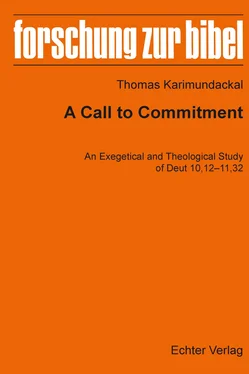• In 11,10b 4QPhyl a, 4QPhyl kand 8QPhyl recall the Smr reading אתם באים instead of אתה בא in the MT. 164
• In 11,11b 4QPhyl kand 8QMez have the LXX’s reading of sionopsúp (באים) instead of the MT’s עברים.
3.5.4 Alterations by addition/omission of words and linguistic correction
The texts of the Phylacteries and the Mezuzot are often expanded and exhibit signs of correction.
• In 10,15a 8QPhyl replaces the Hebrew verb with an Aramaic verb, presenting the full phrase as בעי את אבתיכם in place of the MT’s 8 .באבתיך חשׁקQPhyl also renders על־כן instead of רק.
• In 10,20c 8QPhyl has תקרב instead of the MT’s תדבק.
• In 10,20d 8QPhyl has ובעמו which is probably an uncertain reading for the MT’s ובשׁמו.
• In 10,21a 4QPhyl kthe sentence begins with the כי conjunction כי הואה.
• In 10,21c האלה is omitted in 8QPhyl and it has הנוראו with a I, which is probably understood for the plural הנוראות.
• In 10,21d 8QPhyl has ביעניכם instead of the MT’s 165.ראו עיניך
• In10,22a 8QPhyl has בשׁבע instead of the MT’s בשׁבעים. In 8QMez and 4QPhyl kthe verse begins with the כי conjunction (כי בשׁבעים).
• In 11,9a 8QPhyl reads ירבו ימיכם in place of MT’s תאריכו ימים.
• In 11,10b the Qumran texts, such as 4QPhyl a, 4QPhyl kand 8QPhyl repeat the Smr reading אתם באים instead of אתה בא.
3.5.5 Variations among the Qumran manuscripts
There are also instances where the Qumran readings differ from each other. 166Most of the variations among the Qumran texts are due to additions, omissions, orthographical or morphological changes and altered sequences in the texts. For example:
• In 10,13a the Qumran texts show variations in the treatment of חקתיו. While 4QPhyl khas 8,חקתיוQPhyl has only חקיו and 4QPhyl ahas a different word order with the addition of the pronominal suffix את חוקו ומצאותו.
• In 10,22a while 8QPhyl has 4,אבתיךQPhyl khas אבותיכה.
• In 11,1b 4QPhyl kand 8QMez support the MT’s reading ושׁמרת משׁמרתו וחקתיו while 8QPhyl reflects the Smr with a slight variation of חקיו. Regarding the sequence of 4 ,וחקתיו ומשׁפטיו ומצותיוQPhyl pand 8QMez follow the sequence of וחקתיו ומצותיו ומשׁפטיו (cf. 8,11; 26,17; 30,16), while 4QPhyl kand 8QPhyl follow the sequence of the MT.
• While in 11,6d, 4QDeut k1has 4 ,בקרבQDeut jhas מקרב.
• In 11,8a 4QDeut jand 4QDeut k1expand המצוה as החקים והמשׁפטים as in 5,31; 6,1; 7,11. However, 8QMez lacks המצוה.
• In11,8c 8QPhyl (תחיו ויטבו ימים) and 4QPhyl k(תחזקו ועברתמה) show significant differences in their renderings of תחזקו.
• In 11,10f 1QDeut ahas 4 ,והשׁקית ברגלךQDeut chas a corrected plural version ברגליך. However, we see a slightly different version (ברגליכה) in 4QDeut k1.
• In 11,12b 4QDeut kland 4QPhyl kleave שׁנה indefinite, while 8QPhyl makes it definite.
Summary: Most of the Qumran manuscripts differ only a little from the consonantal text of the MT, and thus come close to the MT. The basic agreement among the Qumran texts suggests that all go back to a common or at least to a similar origin. Many of the variant readings are in orthography, with a strong preference for plene spellings and morphological details. Certain Qumran Texts have a textual character similar to that of the Smr or the LXX, although it is difficult to ascertain a certain textual character due to their fragmentary nature. The texts of Phylacteries and Mezuzot are by and large expanded by the addition of certain words or phrases and show signs of linguistic corrections. The differences among the Qumran texts are characterized mainly by additions, omissions, orthographical changes and altered sequences in the texts.
3.6 Conclusion
Basically, the Smr, the LXX and the Qumran manuscripts agree in most parts with the MT in terms of content, sequence and word order. Therefore, the Smr, the LXX and the Qumran manuscripts provide insight into the state of the MT in that period. The variants encountered in the Smr, the LXX and in the Qumran manuscripts can be mostly described as additions, omissions, changes and altered sequences in the texts. Apart from the orthographical changes, most of the alterations in the Smr, the LXX and in the Qumran manuscripts are either due to the theological interests of the translator, the community or because of the harmonizing tendency of the Smr, the LXX and the Qumran manuscripts. Thus, the variant readings of the Smr, the LXX and the Qumran manuscripts can become an important aid for understanding the MT when used reasonably.
1For the methodological significance of delimiting the text, identifying its context and translating it literarily adhering closely to the MT and making text-critical evaluations for the interpretation of the text, see FISCHER, Wege, 6-9.
2In 10,11 Moses ends the account begun in 9,1 by giving a concluding summary which has its climax in Yhwh’s command to Moses to return to the people to lead them to the Promised Land, cf. LOHFINK, Hauptgebot, 207-218; MCCONVILLE, Deuteronomy, 190-191; NIELSON, Deuteronomium, 119.
3בעת ההוא is a formula which refers mostly to a time or period in the past, cf. JENNI, 953 ,עת. In a narrative discourse this phrase is generally used with a wayyiqtol to introduce or connect the subsequent narration (cf. Gen 21,22; Judg 3,29; Josh 5,2). However, this phrase appears in certain retrospective nominal clauses (cf. Num 22,4; Judg 4,4; 14,4) and in certain prophetical promises and threats (cf. Isa 18,7; Jer 3,17; 4,11; 31,1; Zeph 3,20). In Deuteronomy this phrase is used to distinguish between the narrative time of the speaker and the specific events that took place in the history of Israel. Thirteen of the fifteen occurrences of בעת ההוא in Deuteronomy, which are restricted to the chapters 1-10, are related to Yhwh’s command in the past and the subsequent obedience to that command (cf. 1,9.16.18; 2,34; 3,4. 8.12.18.21; 4,14; 5,5; 10,1. 8; cf. 3,23; 9,20).
4היום in Deuteronomy has different temporal significance, varying from Israel’s past stay in Horeb, Kadesh, Arnon, to their present situation in Moab, to their future life in the Promised Land, to their retrospection of exilic situation. However, the call to the present moment and its actualization take precedence over its past and future references, cf. MARKL, Frameworks , 277. For a detailed analysis of the various temporal nuances of היום in Deuteronomy, see also MARKL, Volk , 70-79, especially the table in 77; idem, Heute, 7-9; According to VON RAD, Theology II , 90-106, many OT passages describe the present as the opportune time for God’s intervention in history and in Deuteronomy this is especially expressed by היום. For a similar discussion, see also SCHMIDT, Vergegenwärtigung, 169-200.
5ועתה can function either as an adverbial temporal marker with a logical force or as a logical conclusion of a topic that directly precedes it, cf. NICCACCI, Syntax, 100-101; BHRG §4:44.6.1. In a narrative discourse, עתה usually introduces a speech and moves away from the circumstances of the actual situation of the discourse, inviting a reaction from the audience, cf. JENNI, 957-58 ,עת. The logical ground for ועתה can extend to many chapters, cf. BHRG §4:44.6.1. On the pragmatical function of ועתה, cf. JENNI, Verwendung, 43-50.
6Cf. WEINFELD, Deuteronomy, 435; VEIJOLA, Bundestheologie, 208.
Читать дальше












